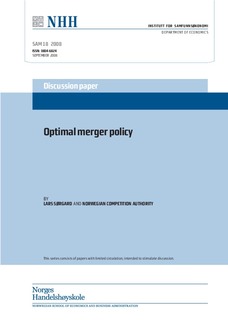| dc.contributor.author | Sørgard, Lars | |
| dc.date.accessioned | 2008-12-18T09:52:54Z | |
| dc.date.available | 2008-12-18T09:52:54Z | |
| dc.date.issued | 2008-09 | |
| dc.identifier.issn | 0804-6824 | |
| dc.identifier.uri | http://hdl.handle.net/11250/163166 | |
| dc.description.abstract | The purpose of this article is to investigate the optimal merger policy in the presence of
deterrence as well as type I and type II errors. We derive the optimal number of merger
investigations, both when the competition authority commits to a particular activity level and
when they do not commit. It is shown that no commitment can lead to a less active merger
policy and lower welfare than what is the case if commitment. If commitment there will be a
positive welfare effect of the merger investigations due to its deterrence effect, while the
merger investigations as such might have a negative impact on welfare (enforcement effect).
The results have important implications for how one should interpret the empirical studies of
the effects of merger enforcement. | en |
| dc.language.iso | eng | en |
| dc.publisher | Norwegian School of Economics and Business Administration. Department of Economics | en |
| dc.relation.ispartofseries | Discussion paper | en |
| dc.relation.ispartofseries | 2008:18 | en |
| dc.title | Optimal merger policy | en |
| dc.type | Working paper | en |
| dc.subject.nsi | VDP::Samfunnsvitenskap: 200::Økonomi: 210::Samfunnsøkonomi: 212 | en |
